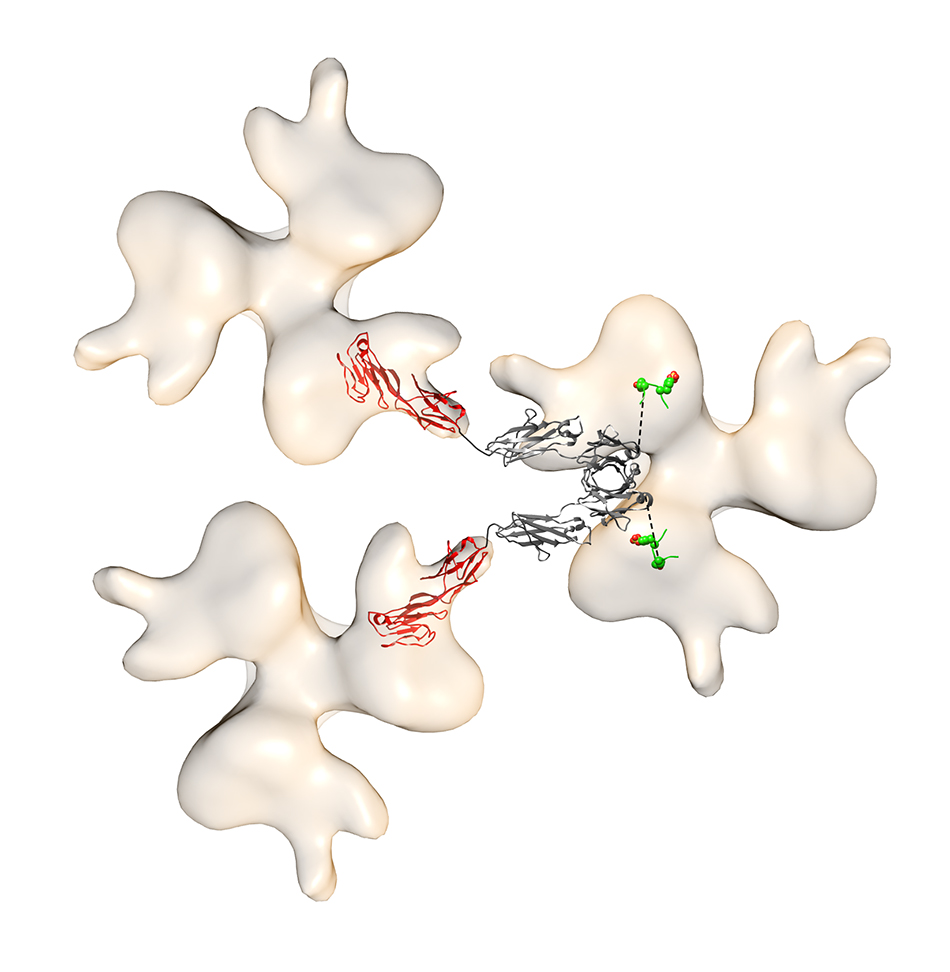A Potential HIV Vaccine

Overview
Originally Published: 02/18/2015
Post Date: 04/29/2015
Similar Articles: See the similar article
Summary/Abstract
A promising Potential HIV Vaccine has been announced by a a team of research scientists at The Scripps Research Institute.
Content
A Potential HIV Vaccine
|
Michael Farzan is a professor at the Florida campus of The Scripps Research Institute.
|
 |
The image shows the part of HIV – shown in beige – that attaches to two receptors, CD4 and CCR5. Scripps Research Institute scientists and colleagues developed a drug candidate that binds both sites simultaneously. The drug includes part of CD4 (red), connected to a mimic of CCR5 (green). These parts are connected by a conserved piece of an antibody (gray). Because the inhibitor binds both sites simultaneously, it binds tightly and triggers the virus to change its shape, blocking HIV-1 more effectively than any currently available antibody therapy. |
HIV evolves quickly, which has been a key challenge for scientists who have been attempting to develop a successful vaccine for more than three decades. Now, a team of TSRI scientists has announced the creation of a novel drug candidate that is so potent and universally effective it might work as part of an unconventional vaccine to prevent HIV from infecting cells.
Using an approach that resembles gene therapy or transfer (rather than eliciting an immune response, as in conventional vaccines), the new drug candidate has been shown to block every strain of HIV-1, HIV-2, and SIV (simian immunodeficiency virus) that has been isolated from humans or rhesus macaques, including the hardest-to-stop variants. It also protects against much higher doses of virus than occur in most human transmission, and it does so for at least eight months after injection.
“Our compound is the broadest and most potent entry inhibitor described so far,” said Michael Farzan, a Scripps Florida professor who led the effort. “Unlike antibodies, which fail to neutralize a large fraction of HIV-1 strains, our protein has been effective against all strains tested, raising the possibility it could offer an effective HIV vaccine alternative.”
An estimated 35 million people are infected with HIV, but only 13.6 million receive the antiretroviral therapy that controls the virus and allows them to lead relatively normal lives. The new treatment could not only function as a vaccine, but also lead to a new therapy for those living with HIV.
When HIV infects a cell, it targets the CD4 lymphocyte, an integral part of the body's immune system. HIV fuses with the cell and inserts its own genetic material, transforming the host cell into an HIV manufacturing site. The new study builds on previous discoveries by the Farzan laboratory, which show that a co-receptor on CD4 cells called CCR5 contains unusual modifications in the region where HIV binds to it, and that proteins based on this region can be used to prevent infection.
Dr. Farzan and his colleagues developed the new drug candidate so that it binds to two sites on the surface of the virus simultaneously, preventing entry of HIV into the host cell. “When antibodies try to mimic the receptor, they touch a lot of other parts of the viral envelope that HIV can change with ease,” said TSRI Research Associate Matthew Gardner, the first author of the study with Lisa M. Kattenhorn of Harvard Medical School. “We've developed a direct mimic of the receptors without providing many avenues that the virus can use to escape, so we catch every virus thus far.”
The team also leveraged preexisting technology in designing a delivery vehicle – an engineered adeno-associated virus, which is a small, relatively innocuous virus that causes no disease. Once injected into muscle tissue, like HIV itself, the vehicle turns those cells into “factories” that could produce enough of the new protective protein to last for years, perhaps decades, Dr. Farzan said.
Data from the new study showed the drug candidate binds to the envelope of HIV-1 more potently than the best broadly neutralizing antibodies against the virus. “This is the culmination of more than a decade's worth of work on the biochemistry of how HIV enters cells,” Dr. Farzan said. “When we did our original work on CCR5, people thought it was interesting, but no one saw the therapeutic potential. That potential is starting to be realized.”
If further pre-clinical trials produce positive results, Dr. Farzan hopes the compound can proceed to human trials






